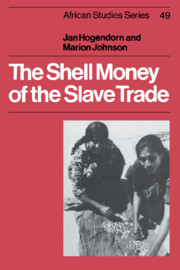Book contents
- Frontmatter
- Contents
- Maps
- Tables and chart
- Preface
- Introduction
- 1 The cowrie
- 2 The Maldive Islands
- 3 The Portuguese domination
- 4 The Dutch and English enter the trade (seventeenth century)
- 5 Prosperity for the cowrie commerce (eighteenth century)
- 6 Boom and slump for the cowrie trade (nineteenth century)
- 7 Collection, transport and distribution
- 8 Cowries in Africa
- 9 The cowrie as money: transport costs, values and inflation
- 10 The last of the cowrie
- Notes
- Bibliogaphy
- Index
Preface
Published online by Cambridge University Press: 12 October 2009
- Frontmatter
- Contents
- Maps
- Tables and chart
- Preface
- Introduction
- 1 The cowrie
- 2 The Maldive Islands
- 3 The Portuguese domination
- 4 The Dutch and English enter the trade (seventeenth century)
- 5 Prosperity for the cowrie commerce (eighteenth century)
- 6 Boom and slump for the cowrie trade (nineteenth century)
- 7 Collection, transport and distribution
- 8 Cowries in Africa
- 9 The cowrie as money: transport costs, values and inflation
- 10 The last of the cowrie
- Notes
- Bibliogaphy
- Index
Summary
Both Marion Johnson and Jan Hogendorn first became interested in the cowrie shell money of West Africa while living and working there, some 5,000 airline miles from where the shells had actually originated. Marion Johnson, trained in monetary economics at Oxford, was resident in the Gold Coast during 1937–39, but only began her inquiry into the cowrie currency much later, during a four-year stay from 1962 to 1966 in now-independent Ghana. While undertaking research on trade routes at the University of Ghana, Legon, she noted the frequent references by nineteenth-century travellers to the existence of a shell-money standard. Little specific attention had been directed to the cowrie currency since the ambitious German works of the turn of the century, so, with four notebooks filled with material on the subject, she wrote the articles published by the Journal of African History in 1970 that ten years later furnished the impetus for this volume. Work on the cowrie required treatment of the Muslim gold mithqal and the “trade ounce,” the eighteenth-century standard of value with no circulating equivalent, used with such frequency along the West African coast. Two further articles resulted from this research. Most of the writing was done at the Centre of West African Studies, University of Birmingham, where she has been for the past fifteen years.
In 1980 Jan Hogendorn took leave from the Department of Economics, Colby College, as Research Associate in the same center.
- Type
- Chapter
- Information
- The Shell Money of the Slave Trade , pp. xi - xviPublisher: Cambridge University PressPrint publication year: 1986

